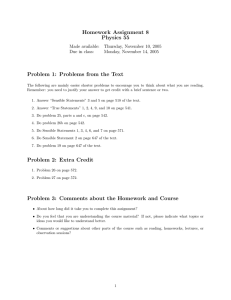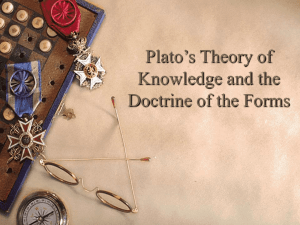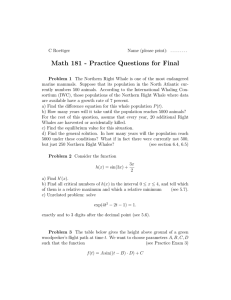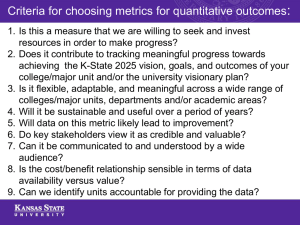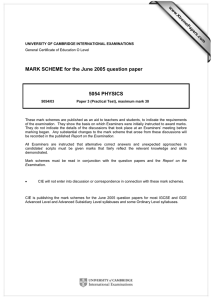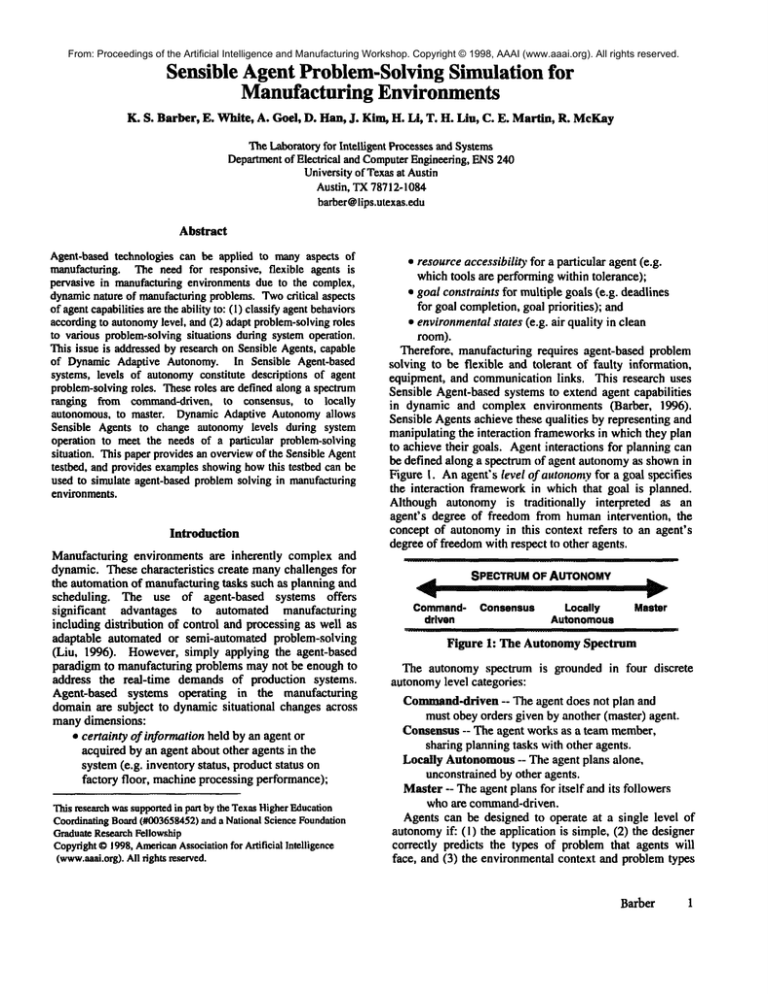
From: Proceedings of the Artificial Intelligence and Manufacturing Workshop. Copyright © 1998, AAAI (www.aaai.org). All rights reserved.
Sensible Agent Problem-Solving Simulation for
Manufacturing Environments
K. S. Barber, E. White, A. Goel, D. Hart, J. Kim, H. Li, T. H. Liu, C. E. Martin, R. McKay
TheLaboratoryfor Intelligent Processesand Systems
Departmentof Electrical and ComputerEngineering,ENS240
Universityof Texasat Austin
Austin, TX78712-1084
barber@lips.utexas.edu
Abstract
Agent-basedtechnologies can be applied to manyaspects of
manufacturing. The need for responsive, flexible agents is
pervasive in manufacturingenvironmentsdue to the complex,
dynamicnature of manufacturingproblems.Twocritical aspects
of agentcapabilitiesare the ability to: (1) classify agentbehaviors
accordingto autonomy
level, and (2) adapt problem-solving
roles
to various problem-solvingsituations during systemoperation.
This issue is addressedby research on Sensible Agents,capable
of Dynamic Adaptive Autonomy.In Sensible Agent-based
systems, levels of autonomyconstitute descriptions of agent
problem-solvingroles. Theseroles are definedalong a spectrum
ranging from command-driven, to consensus, to locally
autonomous, to master. DynamicAdaptive Autonomyallows
Sensible Agents to change autonomylevels during system
operation to meet the needs of a particular problem-solving
situation. This paper providesan overviewof the SensibleAgent
testbed, and provides examplesshowinghowthis testbed can be
used to simulate agent-basedproblemsolving in manufacturing
environments.
Introduction
Manufacturing environments are inherently complex and
dynamic. These characteristics create manychallenges for
the automation of manufacturingtasks such as planning and
scheduling. The use of agent-based systems offers
significant
advantages to automated manufacturing
including distribution of control and processing as well as
adaptable automated or semi-automated problem-solving
(Liu, 1996). However, simply applying the agent-based
paradigm to manufacturing problems may not be enough to
address the real-time demands of production systems.
Agent-based systems operating in the manufacturing
domainare subject to dynamic situational changes across
manydimensions:
s certainty of information held by an agent or
acquired by an agent about other agents in the
system(e.g. inventory status, product status on
factory floor, machineprocessing performance),
Thisresearchwassupported
in part by the TexasHigherEducation
Coordinating
Board(#003658452)
and a NationalScienceFoundation
GraduateResearchFellowship
Copyright
©1998,American
Association
for Artificial Intelligence
(www.aaai.org).
Allrightsreserved.
¯ resourceaccessibility for a particular agent (e.g.
which tools are performingwithin tolerance);
¯ goal constraints for multiple goals (e.g. deadlines
for goal completion,goal priorities); and
¯ environmentalstates (e.g. air quality in clean
room).
Therefore, manufacturing requires agent-based problem
,solving to be flexible and tolerant of faulty information,
equipment, and communicationlinks. This research uses
Sensible Agent-basedsystems to extend agent capabilities
in dynamic and complex environments (Barber, 1996).
Sensible Agentsachieve these qualities by representing and
manipulating the interaction frameworksin whichthey plan
to achieve their goals. Agentinteractions for planning can
be defined along a spectrum of agent autonomyas shownin
Figure I. Anagent’s level of autonomyfor a goal specifies
the interaction frameworkin which that goal is planned.
Although autonomy is traditionally
interpreted as an
agent’s degree of freedom from humanintervention, the
concept of autonomyin this context refers to an agent’s
degree of freedomwith respect to other agents.
SPECTRUM
OF AUTONOMY
Commend-Consensus
Locally
Master
driven
Autonomous
Figure 1: The AutonomySpectrum
The autonomy spectrum is grounded in four discrete
autonomylevel categories:
Command-driven-- The agent does not plan and
must obey orders given by another (master) agent.
Consensus -- The agent works as a team member,
sharing planning tasks with other agents.
Locally Autonomous-- The agent plans alone,
unconstrained by other agents.
Master-- Theagent plans for itself and its followers
who arecommand-driven.
Agents can be designed to operate at a single level of
autonomyif: (I) the application is simple, (2) the designer
correctly predicts the types of problem that agents will
face, and (3) the environmental context and problemtypes
Barber
1
From:
Proceedings
of the Artificial
Intelligence
and Manufacturing
Copyright
1998, AAAI
All rightsconnections.
reserved.
remain
constant.
However,
for complex
applicationsWorkshop.
in
are not© designed
to (www.aaai.org).
support third-party
Third-
dynamic environments (i.e. most manufacturing problems),
the appropriate level of autonomy may depend on the
agent’s current situation. An agent’s optimal autonomy
level maybe affected by the agent’s state, overall set of
goals, and/or its environmental context. All of these
characteristics maybe dynamic and change during system
operation. For example, scheduling agents in charge of
directing parts to various process workstations to achieve
maximumthroughput may perform best by changing their
problem-solving configurations as a result of load
imbalance, the introduction of a new high-priority job, or
machine failure. A Sensible Agent maintains solution
quality in dynamicenvironments by using a technique that
we call Dynamic Adaptive Autonomy (DAA). DAAis
capability that allows a Sensible Agent to modify its
autonomylevel for any goal during system operation. The
process through which an agent chooses the most
appropriate autonomylevel for a given situation is called
autonomy reasoning.
Related Work
The organizational structure of agent-based systems, which
provides the mechanismthrough which agents coordinate
or cooperate to achieve system goals, has been the subject
of much research
over the past few decades
(Chandrasekaran, 1981 ; Fox, 1981; Kirn, 1996; Nirenburg
and Lesser, 1986; Singh, 1990; Smith, 1980; Werner and
Demazeau,1991; Wessonet al., 198 I). One overall goal of
multi-agent-systemsresearch is adaptive self-configuration:
allowing agents to reason about and change the
organization of their coordination frameworks (Gasser,
1988). Most self-organizing systems rely on explicit,
predefined differences in agent behavior and limit the
reorganization primitives to a fixed numberof predefined
behaviors (Gasser and lshida, 1991; Glance and Huberman,
1993; lshida et al., 1992). Others are based on adapting
application-specific
roles that agents can play during
problem solving (Glaser and Morignot, 1997). These
systems do not explicitly represent the agent’s problemsolving role. This limits the ability of these systems to
reason about the appropriateness and potential modification
of an agent’s problem-solving interactions
in an
application-independent fashion.
Multi-agent researchers use simulation environments to
test algorithms and representations in order to accurately
measure the impact of new research. Existing simulation
environments include: DVMT(now DRESUN)(Lesser,
1991), MACE(Gasser et al., 1989), and MICE(Duffee
and Montgomery,1990). Additionally, a numberof singleuse simulations have been used to measure or compare
performance for many research topics including swarm
behavior (Beslon et al., 1998), constraint planning (Liu,
1996), and hierarchical
organizations
(Glance and
Huberman,1993). Unfortunately, most of these testbeds do
not support distributed
heterogeneous computing
environments. Additionally, these simulation environments
2
AIMW-98
party connections allow researchers to compare the
performance of different algorithms and representations
within a commonsimulation enviromnent.
Sensible Agent Architecture
As defined for this research, an "agent" is a system
component that works with other system components to
perform somefunction. Generally, agents have the ability
to act and perceive at somelevel; they communicatewith
one another; they attempt to achieve particular goals and/or
perform particular tasks; and they maintain an implicit or
explicit model of their own state and the state of their
world. In addition, Sensible Agents have many other
capabilities supported by the Sensible Agent architecture
shownin Figure 2.
Each Sensible Agent consists of five major modules
(Martinet al., 1996):
The Self Agent Modelercontains the behavioral model of
this agent (the self-agent) as well as declarative information
specific to this agent. A system designer can specify the
desired services, data, and interfaces of each systemagent
through the Self Agent Modeler. This module interprets
internal or external events acting on the agent and changes
its state accordingly. Othermcxlules(within the self agent)
can access this modelfor necessary state information.
The External Agent Modeler contains knowledge about
other agents and the environment. This modulemaintains
beliefs about states and events external to the self-agent and
predicts the actions of other agents. Other moduleswithin
the self-agent can monitor this modulefor changes that
........................
Interactionwith
other systemagents
Interactionwith
the Environment
/
Perceptionof
Environmentand
external agents
Autonomy
Requests
SYSTEM MODEL
Figure 2: The Sensible Agent Architecture.
From: Proceedings of the Artificial Intelligence and Manufacturing Workshop. Copyright © 1998, AAAI (www.aaai.org). All rights reserved.
Figure 3: Functional View of Simulation Coramunication
affect their reasoningprocesses.
The Action Planner module solves domain problems and
executes problemsolutions. This moduleinteracts with the
environment and other agents in its system. Domainspecific problem solving information, strategies, and
heuristics are placed inside this module. The Action
Planner is able to interpret, plan to achieve, and execute
solutions for domain-specific goals. This module draws
information from all other modulesin the self-agent.
The Conflict ResolutionAdvisor identifies, classifies, and
generates possible solutions for conflicts occurring between
the self-agent and other agents. This modulemonitors the
Action Planner, Self-Agent Modeler, and External Agent
Modelerto identify conflicts. It also offers suggestions to
the Action Planner or Autonomy Reasoner so these
modulesmayresolve the conflict.
The Autonomy Reasoner determines the appropriate
autonomylevel for each goal, assigns an autonomylevel to
each goal, and reports autonomylevel constraints to other
modulesin the agent. It also handles all autonomylevel
transitions and requests for transition madeby other agents.
Testbed Design
Accurate simulation of complex domains requires an
environment that handles complex modeling issues and
produces reasonable visual and numerical output of the
current world state. The Sensible Agent simulation testbed
will provide us with an environmentfor running repeatable
experiments in which Sensible Agent functionality can be
evaluated.
The wide-ranging
functionality
and
implementations of each module requires us to support a
multi-platform and multi-language research environment.
Our current implementation allows us to integrate C++,
Java, Lisp and MOdSIMimplementations on Solaris,
WindowsNT
and Linux platforms.
Figure 3 illustrates the current Sensible Agent simulation
architecture. The different modules and the environment
simulator are implemented as CORBA
objects that can
communicate through the Xerox Inter-Language
Unification (ILU) distributed object environment (Xerox,
1998). ILU provides the necessary cross-language and
distributed object support for our research environment.
ILU’s support of the Object Management Group’s
(OMG) CommonObject Request Broker Architecture
(CORBA)standards allows us to use the OMG
Interface
Definition Language (IDL) to formally define the
interactions amongagents and their modules. The use of
IDL permits continued Sensible Agent evolution in an
implementation-language-independent
manner
and
facilitates parallel research initiatives within the framework
of an integrated distributed object system. Additionally,
ILU’s support of the CORBA
Internet Inter-Orb Protocol
(IIOP) standard will allow us to connect the simulation
with external ORBs(OMG,1998) -- and other applications
that support IIOP - to further enhance the Sensible Agent
Testbed’s extensibility. The use of IIOP combinedwith the
OMG’s CORBAServices Object Naming Services
(COSNaming)
allows us to present a public interface to our
Sensible Agent Testbed, allowing external entities to
connect with our testbed for experimentation
and
collaboration.
We are currently in the process of
integrating the different modules and testing the IIOP
communicationchannel.
The far right of Figure 3 shows how the different
modules within a Sensible Agent can communicate with
each other without loading the inter-agent communication
mediumwith unnecessary message traffic. Figure 4 shows
a logical view of these communication pathways. The
Sensible Agent Template (SAT) provides a single handle
which other Sensible Agents and the environment can use
for the messaging and namingof an individual agent. The
separation of the user interface from other agent
functionality (the far left of Figure 3) allows us to collect
data and view the simulation state without local access to
the heavy computingpowerneeded by the individual agents
and modules.
I
,~
~i’i::’,
:-:.:~
"?’:’"
:..:.p"
:~i~:
"~
..:
.~:’:~.’~
~ ~":’;i.i.:~
ModSimEnvironment Simulator
Figure 4: Logical View of Simulation Communication
Barber
3
From: Proceedings of the Artificial Intelligence and Manufacturing Workshop. Copyright © 1998, AAAI (www.aaai.org). All rights reserved.
¯ ~
~
.~
-r’A’WB
Meet
Deadline
{product
duedate}
-[~ Maintain
Qualityv,#lhin
{tolerance}
-[~ Maximize
{Operator}
Efficiency
-~ MaximizeSystemOutpd
-!~1~_
Batch
Production
{Agent}
-~ MassProduction{Agent}
Figure 5: Sensible Agent System User Interface
Manufacturing Example
As applied to the manufacturing domain, the domainspecific planning responsibilities assigned to each agent
result from object-oriented analysis and design for the
application problem. Decisions regarding levels of
abstraction per agent functional responsibility are madein
the system analysis and design phase. For example, a
process-planning agent maybe defined which encapsulates
resource selection, process selection, and costing services.
Alternatively, each of these services maybe assigned to
individual agents (e.g. process selection agent).
A complete specification
for agents comprising a
particular
Sensible Agent-based system in the
manufacturing domain is beyond the scope of this paper.
However,for the purposes of the following discussions, we
assume a Sensible Agent-based system for job-shop
scheduling. Resources on the factory floor (e.g. material
handling devices, robots, machine operators) can be
assigned to respective agents. Eachof these agents controls
access to production lines (to perform load balancing
between lines) and job scheduling between machines on
different lines (to reduce idle times for any one machine).
The agent makes these decisions by monitoring resource
availability and status, execution, and goal achievement.
The following sections provide examples describing the
Sensible Agent Testbed as it might apply to a
manufacturing simulation. Individual module prototypes
are provided. Weare currently in the process of fully
integrating these modules.
System Designer Interface
The Sensible Agent System User Interface, shown in
Figure 5, provides facilities to initialize the system and
4
AIMW-98
view behavior of the agents during the simulation.
Initialization consists of defining the agents in the system,
assigning the initial goals to the agents, and defining the
environmentalstimuli for the simulation. The definition of
each agent includes declarative knowledge, behavioral
knowledge,and the goal tree from which the agent plans.
During execution, the behavior of each agent can be
displayed, including the internal workingsof each of the
modules, interactions amongmodules, and interactions
amongagents.
Figure 5 shows an example of the definition of a goal
tree. Agents plan from AND/ORgoal trees which
represent the agents’ alternatives (Jennings, 1993; Lesser,
1991). The goal/subgoal relationship reflects a taskreduction planning paradigm. Autonomylevels can be
assigned at a single level or at each step of task reduction
(to each goal, its subgoals, and any further subgoals these
subgoals mayhave).
The goal tree displayed in Figure 5 defines howan agent
wouldmanufacturea part. The top-level goal displayed is
an example of a goal template that would then be
instantiated when placed in an agent’s Intended Goals
Structure. The items in curly braces, "{ }", identify those
variables which must be instantiated in order to begin
planning for a goal. For example, the top-level goal has
{ Agent}, { Part }, and { ProcessPlan } as variables that must
be defined for an agent to accomplishthat goal.
Intended Goals Structure
A Sensible Agent represents the goals it has chosen to
pursue in an Intended Goals Structure (IGS). The IGS
differs from a goal tree. The goal tree contains templates
for candidate goals, which have not been accepted by any
agent. On the other hand, the IGS is an agent’s
representation of the actual goals it will attempt to achieve
From: Proceedings of the Artificial Intelligence and Manufacturing Workshop.
Copyright
© 1998,Production
AAAI (www.aaai.org).
rights
reserved.
Agent
2, Job-Shop
Agent 3" All
shows
that
Agent 1
PlanninLResources 10.0
Agents-Planning Ids 11
~
~. IntendedGoalId
External goal Elements2-1,3-2
1,2,3 -~_
Figure 6: The IGS Viewer
(its ownintended goals) as well as any additional goals for
which it must plan (external goals, intended by other
agents). For a formal definition of agent intention, see
(Cohen and Levesque, 1990). The IGS contains AND-only
compositions of these goals and therefore does not
represent alternative solutions or future planning strategies
as goal trees do. Instead, the IGSrepresents what an agent
has decided to do up to this point. Each agent maintains a
unique IGS as shownin Figure 6.
The example IGS Viewer in Figure 6 shows that
autonomylevels are assigned to each goal in each agent’s
IGS. For example, the information displayed for Agent l’s
goal "Job-Shop Production Agent 1, Job-Shop Production
- ,.~ agent1
Lii
N. AWAnD
FJ:~ ALANNOUNCEMENT
I~ I’ib BID
LB AL AWARD
¯ B OOALASSlONMENT
GOALASSIGNMENT
agent2
B N.ANNOUNCEMENT
t
t
ii By
Lll ALJ~WRD
MessageID
agent1 m3
~.
l=
agentlmO
ParentID
8endingAgent ageflt2
ReceMng
ADent agent1
_-=-_
Subject
AL ANNOUNCEMENT
m GOAL ASSIGNMENT
~3 agent3
¯
B N.ANNOUNCEMENT
BI BID
Lli~ N.AWARD
B gOAL AssigNMENT
Figure 7: CommunicationViewer
i
is a master agent for this goal. Note that Agent I, as
master, must consider its own goal as well as goals
intended by Agents2 and 3 whenit is planning for job-shop
production. This goal is actually a combination of three
intended goals, one for each agent in the planning
framework. The combination of one or more goals is
referred to as a goal element. Each constituent intended
goal in this case is derived from the goal template "JobShopProduction{ Agent},’" where"{ Agent}" is a variable
as described in Figure 5. Agent 2 is command-drivento
Agent I for its corresponding goal "Job-Shop Production
Agent 2." The model of Agent 3’s IGS is not shown.
The details of Agent I’s autonomyassignment for the
selected goal are described in the window
to the right of its
IGS display. For a formal discussion of autonomylevels
and their representations, see (Martin, 1997). Thesedetails
reflect that Agent1 is planning alone for this goal. AgentI
has therefore allocated someamount(10%)of its planningresources toward this goal. As part of this overall goal,
Agent 1 is considering its ownintended goal (id=l) as well
as two external goals intended by Agent 2 (id=2-1, Agent
2-Goal Element Id 1) and Agent 3 (id=3-2). Agent I
authorized to allocate subgoals to Agents1, 2, and 3, and
Agent 1 is completely committedto achieving this goal.
The details of the complementaryassignment for Agent 2,
as a command-driven agent, are shown to the right of
Agent 2’s IGS window.These details reflect that Agent 2
knowsAgent I is planning and has the authority to allocate
subgoals to Agent 2. Notice that Agent 2 is not planning
and therefore allocates no planning-resourcesto the task.
Agent Communication
Sensible Agents use their communication abilities for
allocation
of goals, negotiating
Autonomy Level
Agreements (ALA), and general information passing.
Sensible Agents currently use a protocol based on the
Contract Net Protocol (Smith, 1980; Smith and Randall,
1988) for allocating goals and for allocating planning
responsibility
through ALAs. A contract negotiation
begins with a contract announcement,
followed by bids
from interested agents. Finally the announcing agent
makes a decision and awards the contract to one of the
bidders.
¯Figure 7 demonstrates this process.
An initial
announcement message is highlighted.
Agent 2 is
proposing to enter an ALAwith Agent 1. The body of the
message describes the proposed AL: Agent 2 has a goal,
Minimize{machine} Idle Time, and would like Agent 1 to
be its master for that goal. Wecan see that Agent1 bid and
was awarded the contract.
Both sent and received
messages are displayed as threaded conversations under
both sending and receiving agents. A similar conversation
occurs between Agents I and 3. Subsequent threads show
that Agent 1 uses the GOALASSIGNMENT
message to
assign goals to Agents 2 and 3 under the authority granted
by the Master/Command-drivenAutonomyLevel.
Barber
5
From: Proceedings of the Artificial Intelligence and Manufacturing Workshop. Copyright © 1998, AAAI (www.aaai.org). All rights reserved.
Figure 8: SAM/EAM
Graphical User Interface
Self and External Agent Modelers
Anagent’s behaviors are described by its internal states and
external events as well as system and local goals. An
agent’s understandingof the external world is built fromits
interpretations of the states, events, and goals of other
agents and the environment. A Sensible Agent must be
able to readily perceive, appreciate, understand, and
demonstrate cognizant behavior. Behavioral and declarative
knowledgeare equally important for an agent to understand
itself, other agents, and the environment.
Extended State.charts (ESCs) (Suraj et al., 1997),
derivative of Statecharts (Harel, 1987) with respect
temporal and hierarchical extensions, have been developed
as a comprehensive mechanism for the behavioral
modelingof Sensible Agents. ESCsallow for the explicit
representation of declarable, problem-specific failures.
Exit-safe states represent states whereina sub-state is in a
stable state to process the transition out of a parent state.
That is, events causing a transition between higher level
(parent) states are handled only if the sub-state of the
parents’ state is exit-safe. This extension explicitly allows
the developer to specify certain non-interruptible critical
operations. Nonexit-safe states do not allow for higherlevel state transitions. For example,a part cannot makethe
transition directly to the robot-move state from the onconveyersub-state; the part must be in the ready-for-pickup
¯ sub-state before the part can be movedto the robot agent.
Figure 8 shows ESCgraphical notations and an example of
the behavioral model for an agent. The declarative
knowledgein the SAMis a set of attributes for the self
agent and in the EAM
is a set of attributes for other agents.
The upper left of Figure 8 is a representative set of
declarative knowledgefor this domain. Eachtab represents
agent 3’s beliefs about the other agents and the
environment. If a newagent joins the system, a new tab is
dynamically added to the view.
6
AIMW-98
Action Planner and Conflict Resolution Advisor
Agentsmust interact intelligently, cooperating towards the
completion of goals. The Action Planer (AP) uses a two
staged planning methodologyto (I) improve coordination
amongagents through the use of autonomylevels, and (2)
leverage previous work in the planning field as applied to
various domains(Barber and Han, 1998). The first stage
consists of a hierarchical planner, providing the ability to
differentiate betweenthose activities that are critical to
success and those that are replaceable details. This stage
builds the IGS through the selection of subgoals and
formation of ALAs. ALAs are formed among agents
through the use of KQML
in regards to the selected
subgoals. The secondstage provides an interface to plug in
a domainspecific planner. For each primitive goal in the
IGS, this stage creates a plan by selecting the appropriate
actions to execute. Autonomy
levels are used as a selection
aid for both stages (Barber and Han, 1998). During the
planning process, ccmflicts mayoccur, including goal, plan,
and belief conflicts. Both the IGS and the plan can be
passed to the Conflict Resolution Advisor(CRA)to check
for inconsistencies amongagents.
A Sensible Agent can dynamically select a suitable
conflict resolution strategy according to: (I) the nature
conflict (i.e. goal conflict, plan conflict, belief conflict), (2)
the agenrs social roles (represented by its autonomy
levels), and (3) its solution preferences. Utility is used for
decision making,whichis the total weightedutility value of
a specific solution for its attributes (see (Goelet al., 1996)
for details of definition and calculation of utility basedon
AL). In addition to using utility to evaluate potential
es ae.~,
|ti wom~¢
o~i:,
el i¢*nr,:l
%/ I-II ,,,,,u,,,:,s
"
i
LI
~p~Hac~m::
.....
"
- ~lclr~n~ tle.~ tp eat~
t ¯ wmo~ue.t~,:om~
Figure 9: User Interface for CRA
solutions, agents should also use certain indices (e.g.
effectiveness, performance, agent properties, and system
properties) to evaluate available CRstrategies. Finally the
agent must conduct some trade-off reasoning between
solutions and CRstrategies (Liu and Barber, 1998).
There are three kinds of decision-making styles that
agents can makeby tuning the weight factors:
I. CRstrategies are selected after preferred potential
solutions -- preferred solutions are the most
importanttargets,
2. CRstrategies are selected before preferred potential
solutions -- the solutions will be the natural results
From:ofProceedings
of the Artificial
Intelligenceand
and Manufacturing Workshop.
Copyright
AAAISAM
(www.aaai.org).
All rights reserved.
applying specific
CRstrategies,
Future
work© 1998,
for the
and EAMmodules
includes
3.
Balanced consideration between preferred solutions
and CRstrategies.
In our preliminary experiments (Liu et al., 1997)
followed the secondstyle to design a CRstrategy selection
algorithm for robot path planning. The results show that
conflicts can be successfully resolved and the system can
endure highly dynamicand uncertain environments.
The decision making approach proposed here can also be
applied to conflict resolution problems in multi-agent
systems which require the flexibility of applying multiple
CRstrategies. Figure 9 shows the user interface of the
CRAfor one Sensible Agent. The tree structure shows all
messages this CRAhas sent and received, threaded
causally. The two panels on the right display detailed
information about the selected message. In the scenario
shown, the Action Planner (AP) has requested that the CRA
detect conflicts. After checking its ownIGS and those of
external agents, the CRAreports on detected conflicts and
explains the reason in the displayed message. CRAalso
recommends solutions and CR strategies
to AP which
executes CRstrategies to eliminate conflicts. Execution of
strategies mayinvolve re-planning at either of the stages of
the APor adjusting the beliefs held in the SAMand EAM.
CONCLUSIONS AND FUTURE WORK
The need for responsive, flexible, and sensible agents is
pervasive in manufacturing environments due to the
complex, dynamic nature of manufacturing problems.
Sensible Agents can be applied to many aspects of
manufacturing from incorporation
of manufacturing
knowledge in design to shop floor control, and the
capability
of DAA may prove critical
to the
implementation of agile manufacturing via multi-agent
systems.
System designers cannot predict every
combination of run-time conditions on the factory floor.
Tool status, operator availability, raw material quality and
accessibility, unscheduled maintenance, and machine wear
can all introduce unexpected problems in the process plan.
In order to maintain both high productivity and market
responsiveness, manufacturing systems must be adaptive
and flexible. Dynamic Adaptive Autonomycan provide
agent systems which are capable of being both.
Although the Sensible Agent testbed currently provides
muchof the functionality required for testing Sensible
Agents in manufacturing applications, muchwork remains.
Future work for the APmoduleincludes the construction of
methodsto facilitate the extension of planners or planning
methods with DAAthrough incorporation into SA-based
systems. In addition, automation of the task of autonomy
reasoning (selecting the optimal planning frameworkin
which to plan) is critical to the future development of
Sensible Agent-based systems. We are investigating
techniques of reinforcement learning and case-based
reasoning for this task. These techniques will also be
introduced in the CRA.Weare currently working on a
series of conflict resolution experiments for the CRA.
incorporating more advanced reasoning capabilities and
continuation of work on ESCknowledgerepresentation to
model uncertainty
and time. The communication
capabilities of Sensible Agents will soon be extended to
include a variety of negotiation techniques. Sensible
Agents will also be equipped to reason about which
technique to use in various situations. The simulation
environmentis currently being extended to include support
for inter-ORB communicationand is undergoing testing to
ensure that all internal and external agent messagesare
delivered appropriately.
References
Barber, K. S. 1996. The Architecture for Sensible Agents.
In Proceedings of the International Multidisciplinary
Conference, Intelligent Systems: A Semiotic Perspective,
49-54. Gaithersburg, MD:National Institute of Standards
and Technology.
Barber, K. S. and Han, D.C. 1998. Multi-Agent Planning
under DynamicAdaptive Autonomy.In Proceedings of the
Accepted by 1998 IEEE International
Conference on
Systems, Man, and Cybernetics.
San Diego, CA.
Forthcoming.
Beslon, G., Biennier, F., and Hirsbrunner, B. 1998. MultiRobot Path-Planning Based on Implicit Cooperation in a
Robotic Swarm.In Proceedings of the Second International
Conference on AutonomousAgents, 39-46. Minneapolis/St.
Paul, MN:ACMPress.
Chandrasekaran, B. 1981. Natural and Social System
Metaphorsfor Distributed ProblemSolving: Introduction to
the Issue. IEEE Transactions on Systems, Man, and
CyberneticsI 1(1): 1-5.
Cohen, P. R. and Levesque, H.J. 1990. Intention is Choice
with Commitment.
Artificial Intelligence 42:213-261.
Durfee, E. H. and Montgomery, T.A. 1990. Using MICE
to Study Intelligent DynamicCoordination. In Proceedings
of the IEEEConferenceon Tools for AI.
Fox, M. S. 1981. An Organizational View of Distributed
Systems. IEEE Transactions on Systems, Man, and
Cybernetics11 (1): 70-80.
Gasser, L. 1988. Distribution and Coordination of Tasks
Among Intelligent
Agents. In Proceedings of the
Scandinavian Conference on Artificial Intelligence, 1988
(SCA! 88), 189-204.
Gasser, L. and Ishida, T. 1991. A DynamicOrganizational
Architecture for Adaptive ProblemSolving. In Proceedings
of the Ninth National Conferenceon Artificial Intelligence,
185-190.AmericanAssosciationfor Artificial Intelligence.
Gasser, L., Rouquette,N. F., Hill, R. W., and Lieb, J. 1989.
Representing and Using Organizational Knowledgein DAI
Systems. In Distributed Artificial Intelligence, eel. 2,
Gasser, L. and Huhns, M. N., Eds. London: Pitman/Morgan
Kaufman,55-78.
Barber
7
From:
Proceedings
the Artificial
Intelligence
Manufacturing
Workshop. Copyright
© 1998,inAAAI
(www.aaai.org).
All rights
reserved.
Glance,
N. S.ofand
Huberman,
B. A. and
1993.
Organizational
Assistance
Distributed
Office
Environments.
Fluidity and Sustainable Cooperation. In Proceedingsof the
5th Annual Workshopon Modelling AutonomousAgents it,
a Multi-Agent World, 89-103. Neuchatel, Switzerland.
Glaser, N. and Morignot, P. 1997. The Reorganization of
Societies
of Autonomous Agents. In Multi-Agent
Rationality: Proceedings of the Eigth EuropeanWorkshop
on Modeling AutonomousAgents in a Multi-Agent World,
Boman, M. and van de Velde, W., Eds. New York:
Springer,98-I I I.
Goel, A., Liu, T. H., and Barber, K.S. 1996. Conflict
Resolution in Sensible Agents. In Proceedings of the
International Multidisciplinary Conferenceon httelligent
Systems: A Semiotic Perspective, 80-85. Gaithersburg, MD:
National Institute of Standards and Technology.
Harel, D. 1987. Statecharts:
A Visual Formalism for
Complex Systems. Science of Computer Programming8:
231-274.
Ishida, T., Gasser, L., and Yokoo,M. 1992. Organization
Self-Design of Distributed Production Systems. IEEE
Transactions on Knowledge attd Data Engineering 4(2):
123-134.
Jennings, N.R. 1993. Commitmentsand Conventions: The
Foundation of Coordination in Multi-Agent Systems. The
KnowledgeEngineering Review 8(3): 223-250.
Kirn, S. 1996. Organizational Intelligence and Distributed
Artificial Intelligence. In Foundations of Distributed
Artificial
Intelligence,
Sixth-Generation Computer
Technology Series, O’Hare, G. M. P. and Jennings, N. R.,
Eds. NewYork: John Wiley &Sons, Inc., 505-526.
Lesser, V.R. 1991. A Retrospective
View of FA/C
Distributed Problem Solving. IEEE Transactions on
Systems, Man,atut Cybernetics 21 (6): 1347-1362.
Liu, J. S. 1996. Coordination of Multiple Agents in
Distributed ManufacturingScheduling. Ph.D. Dissertation,
The Robotics Institute, Carnegie MellonUniversity.
Liu, T. H. and Barber, K.S. 1998. Selection of Conflict
Resolution Strategies in Dynamically Organized Sensible
Agent-based Systems. Forthcoming.
Liu, T. H., Chuter, C., and Barber, K.S. 1997. Virtual
Environment Simulation for Visualizing
Conflict
Resolution Strategies in Multiple Robot Systems. In
Proceedings of the 5th lASTEDInternational Conference,
Robotics and Manufacturing, 154-158. Cancun, Mexico:
IASTEDPress.
Martin, C.E. 1997. Representing Autonomyin Sensible
Agent-based Systems. Master’s Thesis, Department of
Eloctrical and ComputerEngineering, University of Texas
at Austin.
Martin, C. E., Macfadzean,R. H., and Barber, K.S. 1996.
Supporting Dynamic Adaptive Autonomyfor Agent-based
Systems. In Proceedingsof the 1996 Artificial Intelligence
and Manufacturing Research Planning Workshop, 112-120.
Albuquerque, NM:AAAIPress.
Nirenburg, S. and Lesser, V. R. 1986. Providing Intelligent
8
AIMW-98
In
Proceedings of the ACMConference on Office h!formation
Systems, 104-112.
OMG.(1998) "OMGHomePage." http://www.omg.org/,
Current as of: June 25. 1998.
Singh, M. P. 1990. Group Ability and Structure. In
Decentralized A.L 2, Proceedings t~" the 2nd European
Workshop on Modelling Autonomous Agents in a MultiAgent World, Demazeau,Y. and Muller, J.-P., Eds. SaintQuentinen Yvelines, France: Elsevier Science, 127-145.
Smith, R. 1980. The Contract Net Protocol: High-level
Communication and Control in a Distributed ProblemSolver. IEEE Transactions on Computers 29(12): 11041113.
Smith, R.. G. and Randall, D. 1988. Frameworks for
Cooperation in Distributed Problem Solving. In Readings
in Distributed Artificial Intelligence, Bond,A. H., Ed. San
Mateo, CA: MorganKaufmannPublishers, Inc., 61-70.
Suraj, A., Ramaswamy,S., and Barber, K.S. 1997.
ExtendedState Charts fi~r the Modelingand Specification
of ManufacturingControl Software. Internatiotuzl Journal
of ComputerIntegrated Manufacturing.
Werner, E. and Demazeau, Y. 1991. The Design of MultiAgent Systems. In Proceedings of the Proceedings of the
3rd European workshop on Modelling Autonomous Agents
in a Multi-Agent World, 3-28. Kaiserslautern, Germany:
Elsevier Science Publishers.
Wesson,R., Hayes-Roth, F., Burge, J. W., Staaz, C., and
Sunshine, C.A. 1981. NetworkStructures for Distributed
Situation Assessment. IEEETransactions on Systems, Man,
andCybernetics! 1 ( I): 5-23.
"Inter-Language
Unification."
Xerox.
(1998)
ftp://fip.parc.xerox.com/pub/ihJilu.html. Current as of: June
25, 1998.

